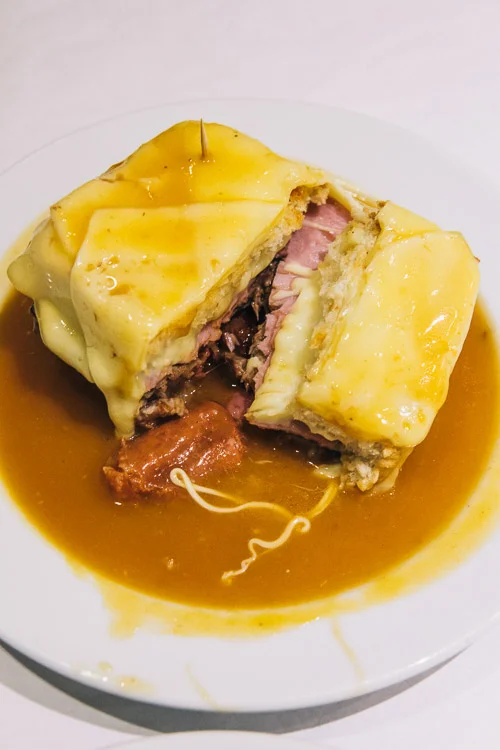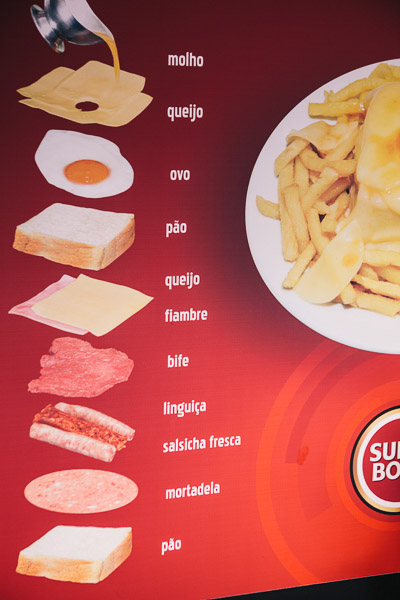The Philly cheesesteak. The club sandwich. The Reuben. Anything between two slices of bread at Katz's Delicatessen. These are all, frankly, ridiculous sandwiches. And as such, Americans may think they have a monopoly on ridiculous sandwiches.
But they've got nothing on Portugal's francesinha, almost certainly the most ridiculous sandwich of all.
According to Tiago Passos, the madness began at A Regaleira, a restaurant opened by his grandfather back in 1935 in the pleasant northern Portuguese city of Porto.
Restaurante A Regaleira, in Porto, Portugal, where the francesinha sandwich was invented in 1952. Image courtesy of Christopher Wise: www.lifecw.com
Passos describes how in the early 1950's, the restaurant hired a chef called Daniel Silva. Silva, who had worked a chef in Angola (a former Portuguese colony) and France, came home from these stints with the notion to do a take on the croque monsieur using local ingredients. According to Passos, Silva supplemented his invention with a sauce that was heavy on the malagueta, a spicy chili from Angola.
"He said that French girls were hot," explains Passos of Silva's inspiration for both the dish's unique seasoning and its name, the latter of which is the feminine diminutive form of the Portuguese for "French", approximately translatable as "little Frenchie".
"Girls in Portugal didn't wear miniskirt then," adds Passos.
A Regaleira claims to follow Silva's original recipe to this day. To make the sandwich, a thick, palm-sized slice of pão forma, plain white bread, is toasted and topped with a slice of ham, fresh sausage and linguiça, a type of Portuguese smoked sausage:
Linguiça and salsicha fresca, just two of the meats in a francesinha sandwich, Restaurante A Regaleira in Porto, Portugal. Image courtesy of Christopher Wise: www.lifecw.com
This is pressed in a modified sandwich press until the sausages are cooked.
The special grill to make a francesinha sandwich, Restaurante A Regaleira, Porto, Portugal. Image courtesy of Christopher Wise: www.lifecw.com
They're then topped with a slice of roast pork, another slice of toasted bread, and a couple slices of queijo flamengo, a mild cheese, and put back into the press. When heated through, they're then drenched in the molho, a thick, spicy sauce that unites stock, beer, whiskey, port, tomatoes, milk, mustard and chili -- allegedly, that is.
Beer-based tomato sauce poured over a francesinha sandwich, Restaurante A Regaleira, Porto, Portugal. Image courtesy of Christopher Wise: www.lifecw.com
"The sauce is secret," we were told by a waiter. "And not everybody's sauce is the same. If you eat here, the sauce is different than another house."
A beer-based tomato sauce poured over a francesinha sandwich, Restaurante Regaleira, Porto, Portugal. Image courtesy of Christopher Wise: www.lifecw.com
The waiter slid the finished sandwich on our table and said, with confidence, "The best sandwich in the world." And indeed, it is pretty damn good. The francesinha is, despite all its fillings, relatively (again, relatively speaking) small, and voluminous contents merge together in an almost cake- or pie-like way, undoubtedly aided by the rich, binding sauce and all that melted cheese. And if you feel the sandwich is lacking somehow, you can always order a francesinha especial, which comes topped with a fried egg and a side of French fries.
A Regaleira Rua do Bonjardim 87, Porto, Portugal +351 22 200 6465
Cafe Santiago, in business since 1959 and ostensibly Porto's second-most famous place to get a francesinha, can't claim to have invented the sandwich, but they've upped the ante by cramming it with even more stuff. Here's a cross- section:
The list of ingredients for the version of francesinha sold at Cafe Santiago, Porto, Portugal. Image courtesy of Christopher Wise: www.lifecw.com
Between these those slices of bread, you have cheese, ham, beefsteak, cured sausage, fresh sausage and mortadella. Yet the sandwich (shown at the top of this post) has less character, perhaps due to its uniform appearance and distinctly mild sauce that packs none of the spiciness of A Regaleira's.
But it's still, frankly, ridiculous.
Cafe Santiago Rua de Passos Manuel 198, Porto, Portugal +351 22 208 1804 11am-11pm
I've made francesinhas twice now, and my recipe is a blend of the two styles described here: the over-the-top fillings and tidy, symmetrical appearance of Cafe Santiago's version, and the full-on spicy sauce of A Regaleira.
Francesinha
Makes six large sandwiches
Ingredients
For the molho 250g beef bones 300g beef shank 1 small onion, peeled and halved 1 medium carrot, peeled and quartered 6 small dried chilies 2 bay leaves 2 cloves garlic 6 cups water 2 tablespoons butter 1 large onion, peeled and chopped 3 cloves garlic, peeled and minced 1 can (140g) of double strength/doppio tomato paste 1 can (330ml) beer 1 cup milk 1 tablespoon yellow mustard 1 tablespoon piri-piri oil or sauce 2 tablespoons salt 2 tablespoons cornstarch
For the sandwiches 12 slices relatively thick white bread, toasted 6 slices/200g mortadela 6 small/250g fresh sausage links 3 small/130g linguiça 6 small (approximately 100g each) beef steaks, pounded until thin 6 slices/200g ham 24 slices/450g queijo flamengo (or Edam) cheese
Procedure
To a large stockpot over high heat, add beef bones, shank, onion, carrot, chilies, bay leaves, garlic and water. Bring to the bowl, reduce heat and allow to simmer for 1.5 hours.
Strain stock, discarding solids. Set stock aside.
To large stockpot over medium heat, add butter, onion and garlic. Saute, stirring frequently, until onions are soft and translucent, about five minutes. Add tomato paste, stirring frequently, until combined and oil begins to re-emerge, another five minutes. Add reserved stock, beer, milk, mustard, piri-piri, salt and cornstarch. Increase heat slightly, stir to combine and bring to the boil. Reduce heat and allow to simmer for five minutes or so until slightly reduced and somewhat emulsified. Using an immersion blender or via pouring mixture into a blender, blend until thoroughly uniform and emulsified. Return to stockpot and allow mixture to simmer until reduced by nearly approximately a third, is thick, spicy and meaty, approximately 45 minutes to 1 hour.
To a griddle or a frying pan over medium-high heat, add the fresh sausage links and linguiça and fry on both sides until done, about five minutes. Remove and set aside. Increase heat to high, add steaks and sear on both sides, about a minute on each side. Set aside. When cool enough to handle, halve linguiça and sausage links lengthwise.
While molho is still simmering, prepare the sandwiches. On a large oven tray, arrange six slices of toasted bread. Top each with one slice of mortadela, half a linguiça, two halves of a sausage link, one steak, one slice of ham and a slice of bread. Drape four slices of cheese over each sandwich, covering it completely. Assemble sandwiches on tray and bake at a high heat or broil until cheese is soft, but not bubbling, about five minutes.
To serve, put one francesinha in a shallow bowl and pour approximately 3/4 cup of the molho directly over the sandwich.


















